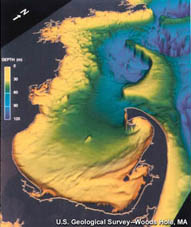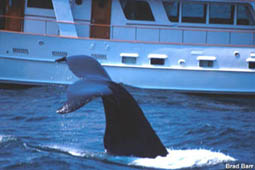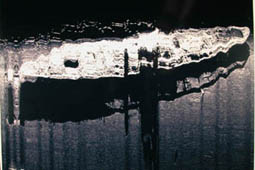
![]()
Volume 6, No. 4
Promoting Cooperation to Maintain and Enhance
Environmental Quality in the Gulf of Maine
|
|
|
|
|
|
|
|
|||||||
|
|
|
|
Browse the archive |
|
|
|
|
Stellwagen Bank:
Public meetings explore future of federally
protected marine area
By Maureen Kelly
The effects of trawling on sea floor habitat, more protections for marine mammals and concerns about overregulating the shipping and fishing industry, were among some of the topics debated in a series of public meetings along the New England seacoast in September and October on the future management of Stellwagen Bank National Marine Sanctuary (SBNMS). Created by Congress in 1992, Stellwagen is one of thirteen U.S. marine sanctuaries, encompassing an area about the size of Rhode Island at the mouth of Massachusetts Bay, between Cape Ann and Cape Cod. It is the only permanent federally protected marine area in the Gulf of Maine.
 |
| Stellwagen Bank sits like a wall at the edge of Massachusetts Bay, forcing water from the Gulf of Maine and waters inside the bay around its edges and over its surface. |
Despite its protected status, a variety of human activities occur within Stellwagen’s boundaries. Stellwagen is used for commercial and recreational fishing, scientific and educational purposes, whale watching, and recreational boating. The main shipping lane for vessels entering the port of Boston cuts through the sanctuary.
Underwater archeology is a growing area of interest in Stellwagen as well, as evidenced by the discovery last summer of the steamer Portland, which sank in a gale in 1898. Although shipwrecks are the current focus of archaeological efforts, Stellwagen’s waters may be covering other cultural resources including pre-historic remains from the days when Stellwagen was dry land, said Craig D. MacDonald, superintendent of SBNMS.
As the National Oceanic and Atmospheric Administration (NOAA) revises its management plan to protect Stellwagen’s wildlife, natural and cultural resources, the agency’s administrators have the challenging task of considering the concerns of all who use the sanctuary’s resources. The plan, now under review, is a "blueprint for all the activity" that goes on in Stellwagen, MacDonald said. He added that the "scoping" meetings held this fall aimed to "understand everyone’s interests" and to determine if there are overlapping concerns among various stakeholder groups.
As steward of this ocean area, NOAA is "trying to weave the bigger picture," said Katrina Van Dine, SBNMS management plan coordinator. "This is more than just fisheries issues."
"A lot of people care deeply about the ocean," she added, explaining that NOAA is considering broader issues of ecosystem management.
 |
| Large numbers of boats travel into the sanctuary to watch whales. Scientists are interested in knowing whether sound levels are loud enough to hurt whale hearing or if noises are causing whales to change their behaviors. |
Charged with what could be an impossible job of pleasing all stakeholders, Van Dine said that NOAA is striving to get beyond the contentiousness that discussions over access to natural resources often engender. Sometimes people come to these meetings "in their warrior suits, ready to do battle," she said, even though all stakeholders share the common interest of protecting resources and maintaining a healthy ecosystem.
During this period of public input, NOAA is acting like a "sponge," Van Dine said, absorbing all the ideas presented to "see what people are thinking."
NOAA held preliminary meetings in 1998 and 1999 that raised issues of public concern including the alteration of the seafloor habitat, marine mammal protection, water quality, public awareness of the sanctuary and effective law enforcement.
These issues resurfaced in the most recent round of meetings. At a forum held in Gloucester, Massachusetts, a polite air of discord pervaded one roundtable discussion group.
While one participant called for more protection of bottom habitat from the effects of trawling, a fisherman countered by objecting to "knee-jerk reactions" to perceived threats from trawling. He suggested that more scientific studies be conducted on the effects of trawling on the ocean bottom habitat.
"We should get the facts," he said, and clear up the "strip-mining and clear-cutting myths" associated with mobile gear fishing.
Fishermen were well represented at the Gloucester forum, some voicing fears about more closures, such as the 1998 decision that shut down part of Stellwagen to fishing to protect groundfish.
Other participants addressed problems caused by fishing gear by calling for improved regulations for the protection of marine mammals threatened by entanglement.
The Center for Coastal Studies estimates that as many as 100 to 200 whales interact with fishing gear in the Gulf of Maine each year, some encounters resulting in minor injuries, others in death. This year alone CCS disentangled five humpback whales (one later died) and two right whales (one was partially disentangled) in the Gulf. CCS reports that the total number of whales entangled in the Gulf is difficult to determine because only a fraction are reported.
Ship strikes are another major cause of whale injuries and death. Suggestions for preventing collisions included enforcing speed restrictions on vessels and tightening guidelines overseeing the whale watch industry.
"Attention needs to be paid to everyone who’s out there," said one commenter who suggested that Coast Guard Auxiliary vessels increase their presence on Stellwagen.
A contrary voice warned against "regulating ourselves to death" and stated that more vessels in the area would create more problems.
 |
| NOAA side scan sonar image view of the Portland as it rests at the bottom of the ocean. Photo: NOAA |
"We need to be aware of all sources of pollution to sustain the fishing industry," one woman said speaking of pollutants flowing seaward from the increasingly urbanized land.
Another man echoed the need to protect landward areas outside Stellwagen’s boundaries, such as marshlands that serve as nurseries for many commercial fish species. We need to keep the ecosystem whole, he said.
Following the public comment period, the Sanctuary Advisory Council–which has members representing the government, scientists, conservationist, educators, and the shipping, whale watch and fishing industries–will distill the comments and identify the major issues of concern. A draft management plan is expected to be ready by next summer or fall when another series of public meetings will occur. Stellwagen’s final management plan is expected to be complete by the summer of 2004..